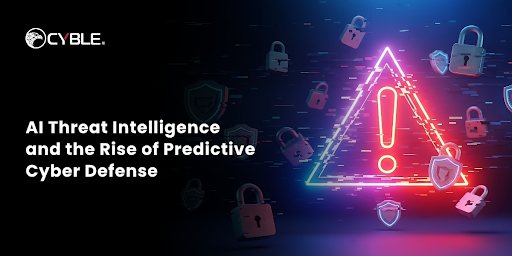AI Threat Intelligence and the Rise of Predictive Cyber Defense

AI Threat Intelligence is more than just gathering the latest IoCs and TTPs of threats. It encompasses a great deal of data collection from multiple sources, to include the dark web forums, network logs, malware repositories, and social channels. AI then analyzes this data in a cohesive way.
Legacy systems relied on rule-based alerts. They were perhaps able to recognize suspicious IPs or malicious file hashes, but they could not observe patterns or understand context. AI changes that prospect. It can discover potential threats after learning from past events and processing current or newly collected potential threat data.
One scenario to explain this, for example, is during a malicious login attempt there could be a log in from a location where your organization does not operate from. AI systems will know that there are suspicious logins from similar attempts in other areas. The connection made is the ability to track activity from existing events for pre-attack tracking and creating the new foundation for the next stage of cyber defense which is cyber predictive defense.
Transitioning from Reactive to Predictive Defense
Cybersecurity has always been a reactive process historically, that is to Detect, Respond, Recover. But as threats change, this is just not working anymore. Instead of worrying about “what just happened”, predictive threat intelligence is pushing us to think more about “what could happen next”.
This change is being driven with the help of AI-enabled cyber security. Because with AI being the engine room, the system can predict potential attack vectors based on historical intelligence and behavioral analysis. AI enabled systems can detect tiny irregularities associated with normal operation of the network activity, and automatically raise the flag for the suspicious activity taking place.
For example: It’s Monday morning at 9 AM, an employee account starts downloading File R – which has an unusually large attachment. A traditional alerting system probably will not flag anything. As long as, everything looks valid with the user credentials, it won’t raise a red flag. However, AI-supported detection tools will be able to analyze it as an abnormal behavior, and in some cases will launch an investigation automatically (even automatically lock the account).
This is what proactive cyber defense looks like- Moving the human down to seconds and minimizing risks and impacts from human delays or mistakes.
The Importance of Predictive Cyber Defense for 2025
The year 2024 revealed the dominance of established players in threat intelligence software, with Fortinet topping the list with a 45.45% share, another vendor accounted for 21.22%, highlighting the importance of real-time insights to secure enterprises.
The increasing number of devices, cloud environments and AI systems connected today has resulted in an explosion of data related to threats; it has become impossible for human analysts to process everything manually. Automated threat intelligence, or AI systems, now aggregate, correlate, and analyze millions of signals to surface hidden risks around the clock.
Organizations utilizing AI Threat Intelligence in 2025 have fewer successful breaches, not because attacks have disappeared, but rather they’ve learned to anticipate any attacks.
The Role of Agentic AI in Cybersecurity
AI has been used for security operations for many years, but the emergence of Agentic AI in cybersecurity is a new chapter in the space. Unlike traditional AI, Agentic AI acts on its own; it does not just notify analysts but actively responds to the threat. You can think of Agentic AI as an intelligent assistant that responds to potential threats without waiting for instructions. For example, if Agentic AI detects that a phishing campaign is happening to employee inboxes, it can autonomously block malicious domains, quarantine suspicious emails, and notify the end-user. This level of autonomy is a must-have for real-time threat identification. Cyberattacks now happen in seconds rather than the hours or days of the past. Humans could never respond that fast. With Agentic AI, that barrier comes down to a few milliseconds.
Smarter Intelligence provided by Cyble
Cyble is a company actively leading this smart revolution. They have designed a Cyber Threat Intelligence Platform, which is a revolutionary solution that gives users a high-level overview of all the security problems that need to be addressed. Instead of data gathering, they propose that security teams should focus on what really counts. Their system made up of AI Threat Intelligence coupled with predictive threat intelligence, makes it feasible for organizations to keep track, evaluate, and respond in much timelier and effective way.
By using automation, Cyble, in a way, helps in shifting the focus of analysts from manual investigation that never ends to decision-making aspects being the prime concern in the process.
As said before, what differentiates Cyble’s option is the feature of being able to change. By using intelligence engine, it can keep observing the dark web for data leaks or threat actors and none of this is being done in a discrete manner and the firm, thus, is able to do the right thing all the time.
Growing Significance of Trust and Ethics as with AI
With the accelerated roll-out for AI (or AI-enabled) cyber security, we are entering a new territory of cyber dilemmas. The foremost challenge is not technical in nature, but rather, it relates to trust. If AI is the decision maker, then who is accountable? What level of transparency is required for AI algorithms?
Most organizations are reluctant to adopt AI due to these reasons. Whether reported as an exploit or another method of attack, systems can be poorly implemented, and algorithms can be improperly configured or insufficient to the threat, leading to faults of commission, or an unwarranted breach and liability.
Under responsbile AI systems, there will always have to be a phase of automation while incorporating a human component to mitigate risk.
The balance of autonomy and responsibility will determine the next frontier of predictive cyber defense.
The Future of AI Threat Intelligence After 2025
As AI Threat Intelligence matures, the divide between detection and prevention will become even more blurred. Systems will not only be able to recognize risks, but also simulate attack scenarios, hypothesize the probable assets under attack, and recommend responses proactively and automatically.
AI will be more aware of the context in which data patterns exist, extending beyond the knowledge of the data patterns to a context of business relevance. For example, it may prioritize a potential exposure of customer data over an attempted generic malware outbreak on a non-critical and non-sensitive system, providing recommendations on response, containment, and recovery based on this context.
As machine learning grows rapidly in the cyber security space, every bit of data is an opportunity to learn, adjust, and improve our defenses. Organizations investing in AI-assisted threat detection and response will do more than being reactive to incidents, they will be able to stay two steps ahead of threat actors.
Conclusion
Cybersecurity will make a change toward prediction and AI Threat Intelligence is going to help security teams identify things that they could ideally never be able to.
Information gathering is historically important when it comes to defense meanwhile the big thing now is to foresee the future incidents. Prediction-based cyber defense and automated threat intelligence emergence are making a major shift in the way companies are protecting themselves now.
They are making the security a thing not reactive but self-directed, very much like a living and learning creature. The human-intelligent system collaboration is the key to the resilience of the digital world as we move ahead.
Cyber defense will NOT be the act of constructing walls BUT the act of avoiding and closing attacks.



